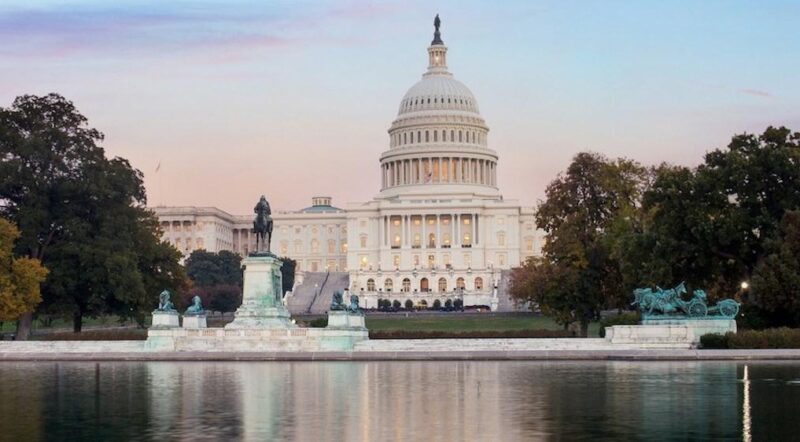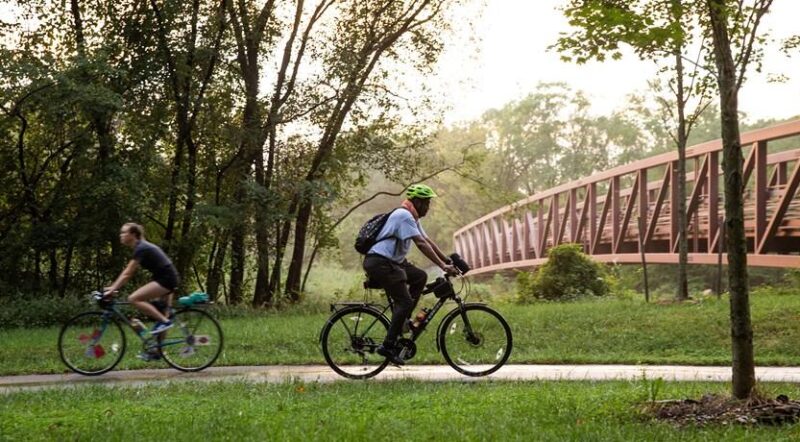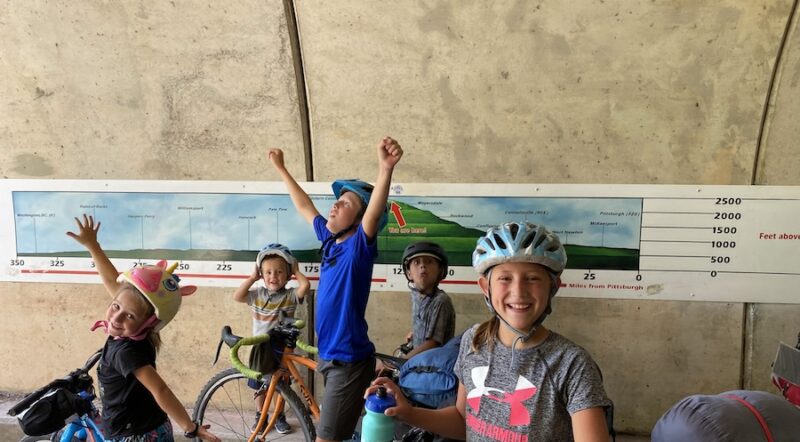RAISE History
Indianapolis Cultural Trail | Photo by TrailLink user orangedoug
Quick Facts:
- Purpose: To invest in road, rail, transit and port projects that achieve national objectives
- What sets it apart: Funds urban and rural multimodal, multijurisdictional transportation projects that are typically harder to support through traditional DOT programs
- Funding Provided: $8.935 billion between 2009-2020
- Maximum Grant Size: $25 million for FY 2021; grant sizes determined by annual appropriations process
- Name: These grants were formerly known as TIGER and BUILD.
Background:
Established in 2009 with the American Recovery and Reinvestment Act as the Transportation Investment Generating Economic Recovery (TIGER) program, this discretionary grant program is one of the few United States Department of Transportation (USDOT) programs that allow both regional and local governments to directly compete for multimodal transportation funding. In 2018, TIGER grants were renamed Better Utilizing Investments to Leverage Development (BUILD) grants and the project selection criteria was altered to favor projects with significant non-federal investments.
Between 2009 and 2020, TIGER and BUILD grants have awarded nearly $8.9 billion for capital investments in surface transportation to 678 projects in all 50 states, the District of Columbia, Puerto Rico, Guam, and the Virgin Islands. These projects include trails and active transportation projects that meet the mobility needs of communities across the country.
What’s New:
In addition to its renaming, each administration can put their unique stamp on this discretionary grant program. In April 2021, the Biden Administration’s USDOT announced their newly renamed FY 2021 $1 billion discretionary grant program, the Rebuilding American Infrastructure with Sustainability and Equity (RAISE) grants. U.S. Secretary of Transportation Pete Buttigieg stated that the program intends to provide much needed investments in transportation projects that improve racial equity, reduce climate change impacts, and create good-paying jobs in communities across the country.
The Biden administration’s stamp on the RAISE grants can be seen through the merit-based criteria they have assessed awards through:1
- Safety
- Environmental sustainability
- Quality of life
- Economic competitiveness
- State of good repair
- Innovation
- Partnership
Maximum RAISE 2021 grant awards were not to exceed $25 million and no more than $100 million could be awarded to a single state. Up to $30 million were to be awarded to planning grants and this includes at least $10 million to Areas of Persistent Poverty. To ensure that both rural and urban communities receive equitable amounts of funding, each category received no more than half of the available $1 billion.
What We’ve Learned:
The selection criteria, eligibility, and requirements outlined by each administration reflect each president’s priorities and national goals for transportation infrastructure. These priorities include trails, walking and biking networks that provide safe and accessible transportation options.
As it relates to active transportation funding, the Obama administration was more likely to give grants solely for trail networks and had a dollar target for such grants in their TIGER program. In contrast, the Trump administration mostly showed its support for bicycling and pedestrian projects as a subset of broader, multi-modal projects in their BUILD grants. Between 2009 and 2018, TIGER provided $350 million for active transportation projects and an additional $1.3 billion for road and transit projects that contained walking and biking elements. In the 2-year span of the grants, BUILD provided around $217 million for projects with clear bicycling and pedestrian elements, with nearly $67 million of that total going to projects with a multi-use trail component. In the last round of BUILD, 28 out of 70 awarded projects incorporated active transportation infrastructure.
Under the Biden administration, projects that could demonstrate improvements to racial equity, climate change mitigation, and job creation were slated to be prioritized within this award round, making trail and active transportation projects well positioned to be more competitive than in previous rounds. In an unprecedented level of funding for trails and active transportation projects, projects that were solely or mainly about trails secured 19% of the overall funding in addition to 21% of funding going towards projects that were predominantly to make roads safer for vulnerable road users like bicyclists and pedestrians.
Many of the successful projects in this round of RAISE grants focused on increasing connectivity and safety to routine destinations, a key trend among communities that are looking to build their trail and active transportation networks. The round of grants illustrates how trails critical trails and projects that make streets safer for vulnerable road users are for our national transportation priorities, especially in an era of rising pedestrian and bicycle fatalities, alarming climate impacts, and inequitable access to jobs.
These grants show that federal policymakers are increasingly taking notice of rising demand for trails and active transportation projects. While this is remarkable level of funding underscores the critical role these projects play in providing safe, equitable transportation options, these grants are not specific to trails and active transportation projects and they are forced to compete with other transit priorities (e.g., roads and bridges, transit and rail, and ports) and only one in ten of all projects were funded. This makes it difficult for communities to undertake the expense of applying and unmet need. Dedicated funding from innovative new programs like the Active Transportation Infrastructure Investment Program could begin to tackle this unmet need.
Explore trail and active transportation projects funded by TIGER-BUILD-RAISE grants:
- Cleveland Metro Parks $7.95M TIGER Grant
- 5 Trails funded by TIGER
– Indianapolis Cultural Trail
– The Circuit Trails
– Razorback Regional Greenway
– Anacostia Riverwalk Trail
– Atlanta Beltline
Other Resources:
- USDOT RAISE Notice of Funding Opportunity, Guidance, and FAQ
- USDOT Past Applicant List
- USDOT Federal Highway Administration’s RAISE-BUILD-TIGER Discretionary Grants page
- RTC Blog: Federal grants RAISE the bar for Active Transportation Investments
View RAISE Case Studies.
SOURCES
1 https://www.transportation.gov/RAISEgrants
RAISE Stories
View More Blogs
What the 2024 Election Means for Active Transportation

Federal RAISE Grants Illustrate Widespread Demand for Infrastructure That Makes It Safer and Easier to Walk and Bike in Communities Nationwide
